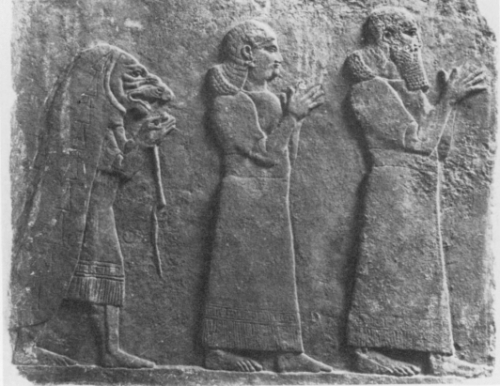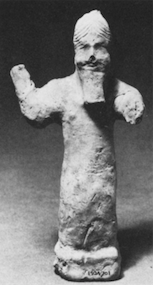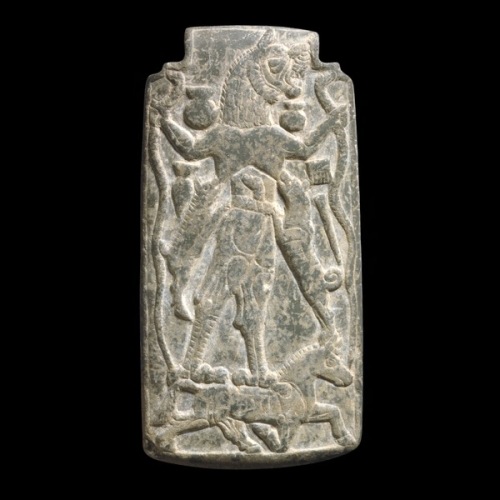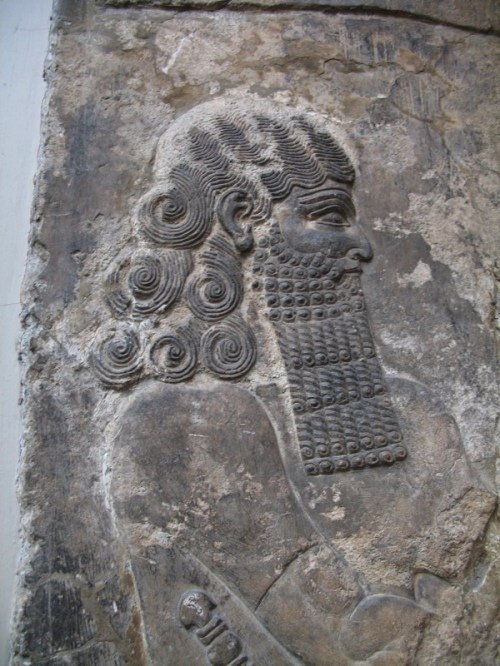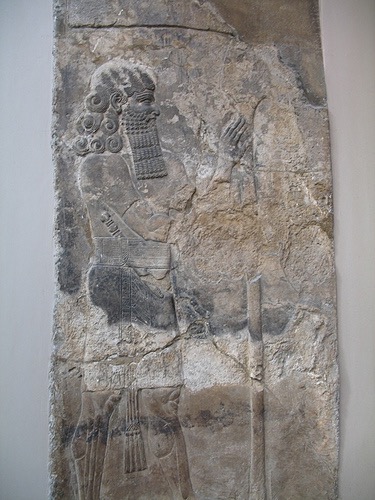Green Identifies the Lahmu and the Ugallu
“Returning to the apotropaic ritual, after the fish-apkallē the text prescribes various kinds of wooden figures which cannot be identified among actual figurines, although some types may, as Dr. Reade suggested, be represented in Assyrian sculpture.

BM 118918, courtesy of the British Museum, plate XId. Green determines in this article that the leonine-headed entity in the center is the ugallu, or “Great lion.”
These wooden figures end, however, with those of the ugallu, “Great-lion,” of which clay examples do exist. The human-leonine figure of Plate XId, centre, is commonly portrayed in glyptic art from the Akkadian period onwards and in seventh-century Assyrian sculpture.
He has been identified by Karl Frank and, with reservations, Ursula Calmeyer, as an utukku-demon (K. Frank, MAOG 14 (1941), idem, Babylonische Beschwörungsreliefs (Leipzig, 1908) … Notice already a figurine of the type used to illustrate the edition of Utukkū Lemnūtu of R.C. Thompson, The Devils and Evil Spirits of Babylonia and Assyria II (London, 1904)), but this view has been challenged by Dessa Rittig (Rittig, 108).
She is unable, however, to offer an alternative identification. Woolley once appears to interpret the creature as the ugallu, but elsewhere in the same paper as the urmahlīlu, “Lion-man,” apparently incorrectly identifying the two. Dr. Reade has suggested alternative identifications as the ugallu or the lahmu.
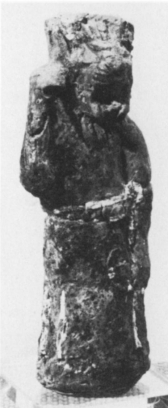
An ugallu, or “Great lion,” ND 8190, courtesy of the Musées Royaux d’Art et d’Histoire, Brussels, Plate XIa.
But the latter creature, as we shall see, appears to have a different identity, and the identification of this human-leonine figure as the ugallu is apparently confirmed by the Nimrud fictile examples (Plate XIa). The inscription (Plate XIb) corresponds well with that prescribed for figures of the ugallu in the ritual.
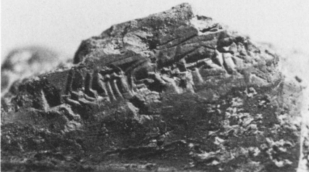
Inscription on the right side of ND 8181 (IM 61854), British School of Archeology in Iraq, photograph by David A. Loggie. Plate XIb. Green states that the “inscription corresponds well with that prescribed for figures of the ugallu in the ritual.”
The type must probably be distinguished from the whip-carrying human figure wearing a lion’s pelt, of which a single example occurs in the Nimrud series (Plate XIIa).
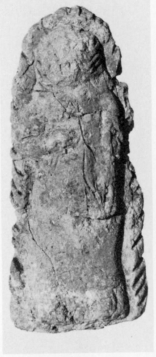
ND 9342, Metropolitan Museum of Art, Rogers Fund, 1957. Plate XIIa. Green states that this is a “whip-carrying human figure wearing a lion’s pelt,” from the Nimrud series.
The type, as R.S. Ellis has shown, is also distinguished on the palace reliefs (Plate XIIc).
Perhaps yet another distinctive type is the Janus-figure of Plate XIIb, having both human and leonine faces, but with no parallels known to me. The identification of both types is unclear.
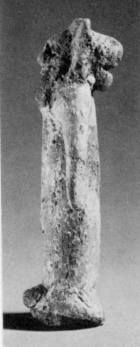
ND 5296, Metropolitan Museum of Art, Rogers Fund, 1957. Green terms this figurine “Janus-faced,” with both leonine and human faces. Plate XIIb.
The next passage of the ritual prescribes clay figures of the lahmu, inscribed and coated in gypsum, with “water painted on them in black wash.” The type of figure to which this passage refers, though not the reading of the Akkadian name, has been well recognized, since plaques from Aššur, inscribed as in the ritual, depict the figure in close conformity to his representation on the monumental reliefs (Plate XId, left).

BM 118918, courtesy of the British Museum, plate XId. Green identifies the ugallu at the center, the “Great lion,” and lahmu at left.
The Nimrud “heroes” are in the main heavily bearded and bewigged men without the distinctive six spiral tresses (Plate XIIIa), but they are nevertheless often inscribed, in the same fashion, and so quite likely represent the same personage.
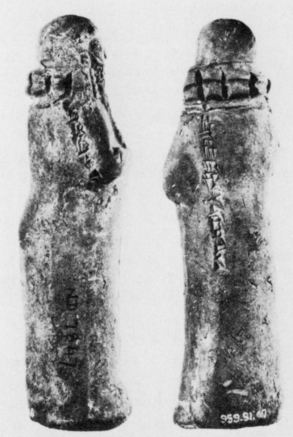
Green states that these figurines are inscribed with statements that they represent lahmu.
ND 7847, Royal Ontario Museum. Plate XIIIa.
Most interesting, perhaps, is a Burnt Palace example on which much of the gypsum coating and painted water survive (Plate XIIIb), as on some similar figures from Ur.
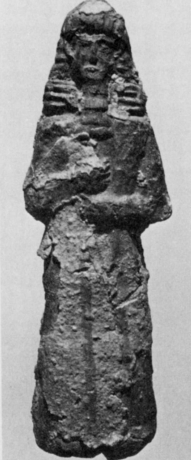
ND 4111 (IM 59290), British School of Archeology in Iraq, photograph by David A. Loggie. Green, Plate XIIIb.
Figurines of a human deity with one arm raised in the air in similar fashion to the ugallu (Plate XIc) have not been found at Nimrud, but the identification of the ugallu from Nimrud figurines allows a possible identification of this personage also.
A common line-up at doorways in the North Palace at Nineveh involves a trio of this god, the ugallu and the lahmu (Plate XId). In the ritual text, moreover, the passages prescribing figurines of the ugallu and lahmu occur together, preceded by a prescription for figures of the “House god” who makes a gesture with his right hand and carries a weapon in his left.

BM 118918, courtesy of the British Museum, plate XId. Green identifies the ugallu at the center, the “Great lion,” and lahmu at left. The lahmu can be distinguished by his idiosyncratic six curled tresses. He speculates that the “House god” appears at far right. Plate XId.
It is possible, therefore, although it cannot be proved, that the three figures of these doorway reliefs are enumerated in the same order in this ritual.”
Anthony Green, “Neo-Assyrian Apotropaic Figures,” Iraq, Vol. 45, 1983, pp. 90-2.

